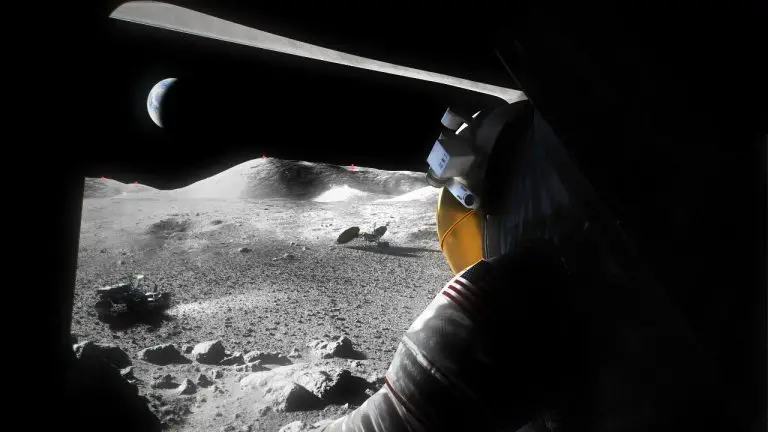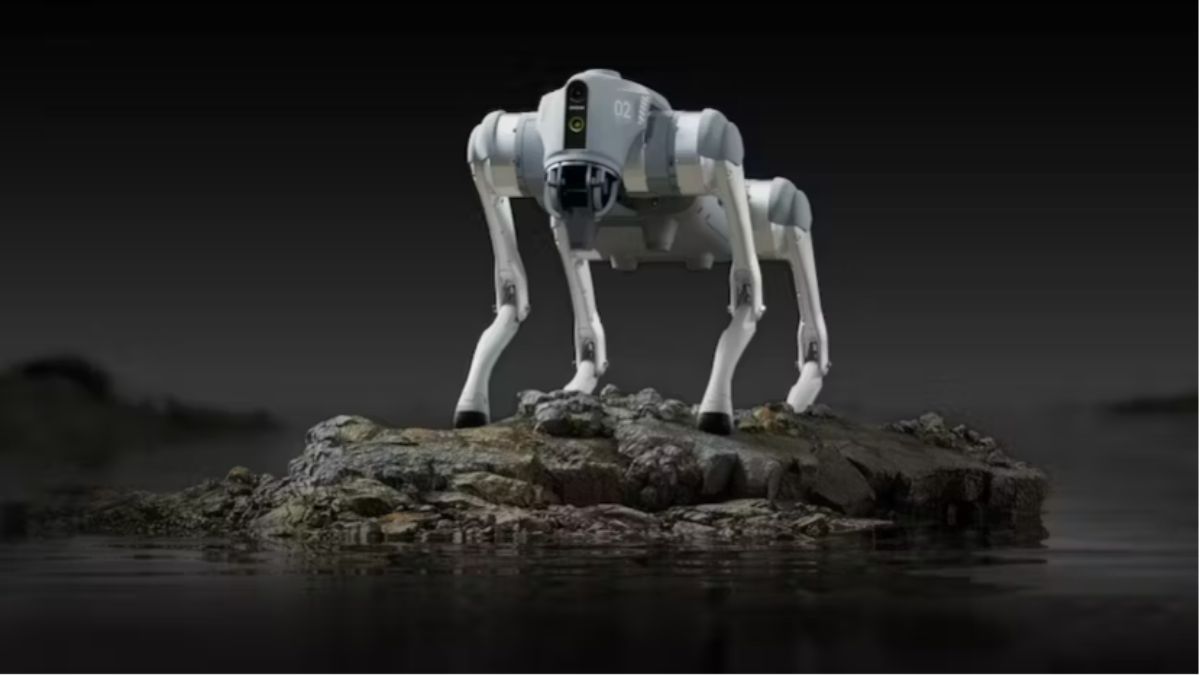NASA selects Blue Origin for a $3.4 billion contract for lunar mission set for 2029
May 22, 2023 By Awanish Kumar

(Image Credit Google)
Blue Moon lander as shown in an artist's rendering. For the 2029 Artemis V mission to the Moon, NASA has hired Blue Origin to create a human landing system. Blue Origin will design, develop, test, and verify the Blue Moon lander, which can support repeated astronaut trips to the lunar surface, as part of the $3.4 billion contract. Image credit : Blue Origin
For the $3.4 billion task of developing a human landing mechanism for the Artemis V mission, scheduled for 2029, NASA has chosen Blue Origin. This action aims to promote competition, cut costs, and support ongoing lunar landings while also opening the door for upcoming Mars missions.
NASA has chosen Blue Origin of Kent, Washington to create a human landing system for the organization's Artemis V mission to the Moon. NASA will explore more of the Moon than ever before with Artemis, making more scientific discoveries and getting ready for manned expeditions to Mars in the future.
In order to comply with NASA's requirements for human landing systems for repeated astronaut missions to the lunar surface, including docking with
Gateway, a space station where personnel transfers in lunar orbit, Blue Origin will design, develop, test, and validate its Blue Moon lander. The contract also calls for design and development work and one unmanned lunar surface demonstration trip before a crewed demonstration on the Artemis V mission in 2029. The firm-fixed-price contract has a $3.4 billion total award value.
“Today we are excited to announce Blue Origin will build a human landing system as NASA’s second provider to deliver Artemis astronauts to the lunar surface,” said NASA Administrator Bill Nelson. “We are in a golden age of human spaceflight, which is made possible by
NASA’s commercial and international partnerships. Together, we are making an investment in the infrastructure that will pave the way to land the first astronauts on Mars.”
Four people will be sent into lunar orbit on the Artemis V mission by NASA's SLS (Space Launch System) rocket in an Orion spacecraft. Two astronauts will board Blue Origin's human landing system after Orion docks with Gateway and travel for about a week to the Moon's South Pole region where they will carry out scientific and exploration tasks. As part of NASA's Moon to Mars exploration strategy, Artemis V is at the crossroads of showcasing the agency's early lunar exploration capabilities and laying the groundwork for repeating sophisticated missions in lunar orbit and on the surface.
[caption id="attachment_175327" align="aligncenter" width="768"]

A depiction of an Artemis astronaut in a suit scanning the lunar surface, the Lunar Terrain Vehicle, and other surface components from a Moon lander hatch. Source: NASA[/caption]
NASA's Artemis program will benefit from having more competitors, lower taxpayer costs, a regular cadence of lunar landings, additional investment in the lunar economy, and assistance in achieving its objectives on and around the Moon in order to prepare for future astronaut missions to Mars.
For the Artemis III mission, the NASA had previously hired SpaceX to demonstrate an initial human landing technology. The ESA also instructed SpaceX to modify its design in order to satisfy the contract's specifications for environmentally friendly exploration and to demonstrate the lander on Artemis IV. Due to the agreement with Blue Origin to demonstrate a lander on Artemis V that satisfies these same sustainable lander requirements, such as the capacity for a larger crew size, a longer mission duration, and the delivery of more mass to the Moon, numerous suppliers will be available to compete for upcoming chances to meet NASA's requirements for lunar surface access for Artemis missions.
By encouraging business to create cutting-edge concepts and designs for human landing systems, NASA will contribute to broader public access to space.
“Having two distinct lunar lander designs, with different approaches to how they meet NASA’s mission needs, provides more robustness and ensures a regular cadence of Moon landings,” said Lisa Watson-Morgan, manager, Human Landing System Program at NASA’s Marshall Space Flight Center in Huntsville, Alabama. “This competitive approach drives innovation, brings down costs, and invests in commercial capabilities to grow the business opportunities that can serve other customers and foster a lunar economy.”
Also read :
Here’s How You Can View NASA’s Announcement Of The Artemis II moon Crew
In September 2022, as part of the continued development of cutting-edge space exploration technologies, capabilities, and concepts, NASA released the solicitation, known as Appendix P, of its second Next Space Technologies for Exploration Partnerships Broad Agency Announcement (Next-STEP2 BAA).
Through Artemis, NASA will send astronauts to the Moon for scientific research, commercial gain, and to lay the groundwork for crewed missions to Mars, including the first woman and person of color. The SLS rocket, Orion, Gateway, cutting-edge spacesuits, and human landing devices make up NASA's deep space exploration infrastructure.
By Awanish Kumar
I keep abreast of the latest technological developments to bring you unfiltered information about gadgets.


 A depiction of an Artemis astronaut in a suit scanning the lunar surface, the Lunar Terrain Vehicle, and other surface components from a Moon lander hatch. Source: NASA[/caption]
NASA's Artemis program will benefit from having more competitors, lower taxpayer costs, a regular cadence of lunar landings, additional investment in the lunar economy, and assistance in achieving its objectives on and around the Moon in order to prepare for future astronaut missions to Mars.
For the Artemis III mission, the NASA had previously hired SpaceX to demonstrate an initial human landing technology. The ESA also instructed SpaceX to modify its design in order to satisfy the contract's specifications for environmentally friendly exploration and to demonstrate the lander on Artemis IV. Due to the agreement with Blue Origin to demonstrate a lander on Artemis V that satisfies these same sustainable lander requirements, such as the capacity for a larger crew size, a longer mission duration, and the delivery of more mass to the Moon, numerous suppliers will be available to compete for upcoming chances to meet NASA's requirements for lunar surface access for Artemis missions.
By encouraging business to create cutting-edge concepts and designs for human landing systems, NASA will contribute to broader public access to space.
“Having two distinct lunar lander designs, with different approaches to how they meet NASA’s mission needs, provides more robustness and ensures a regular cadence of Moon landings,” said Lisa Watson-Morgan, manager, Human Landing System Program at NASA’s Marshall Space Flight Center in Huntsville, Alabama. “This competitive approach drives innovation, brings down costs, and invests in commercial capabilities to grow the business opportunities that can serve other customers and foster a lunar economy.”
Also read : Here’s How You Can View NASA’s Announcement Of The Artemis II moon Crew
In September 2022, as part of the continued development of cutting-edge space exploration technologies, capabilities, and concepts, NASA released the solicitation, known as Appendix P, of its second Next Space Technologies for Exploration Partnerships Broad Agency Announcement (Next-STEP2 BAA).
Through Artemis, NASA will send astronauts to the Moon for scientific research, commercial gain, and to lay the groundwork for crewed missions to Mars, including the first woman and person of color. The SLS rocket, Orion, Gateway, cutting-edge spacesuits, and human landing devices make up NASA's deep space exploration infrastructure.
A depiction of an Artemis astronaut in a suit scanning the lunar surface, the Lunar Terrain Vehicle, and other surface components from a Moon lander hatch. Source: NASA[/caption]
NASA's Artemis program will benefit from having more competitors, lower taxpayer costs, a regular cadence of lunar landings, additional investment in the lunar economy, and assistance in achieving its objectives on and around the Moon in order to prepare for future astronaut missions to Mars.
For the Artemis III mission, the NASA had previously hired SpaceX to demonstrate an initial human landing technology. The ESA also instructed SpaceX to modify its design in order to satisfy the contract's specifications for environmentally friendly exploration and to demonstrate the lander on Artemis IV. Due to the agreement with Blue Origin to demonstrate a lander on Artemis V that satisfies these same sustainable lander requirements, such as the capacity for a larger crew size, a longer mission duration, and the delivery of more mass to the Moon, numerous suppliers will be available to compete for upcoming chances to meet NASA's requirements for lunar surface access for Artemis missions.
By encouraging business to create cutting-edge concepts and designs for human landing systems, NASA will contribute to broader public access to space.
“Having two distinct lunar lander designs, with different approaches to how they meet NASA’s mission needs, provides more robustness and ensures a regular cadence of Moon landings,” said Lisa Watson-Morgan, manager, Human Landing System Program at NASA’s Marshall Space Flight Center in Huntsville, Alabama. “This competitive approach drives innovation, brings down costs, and invests in commercial capabilities to grow the business opportunities that can serve other customers and foster a lunar economy.”
Also read : Here’s How You Can View NASA’s Announcement Of The Artemis II moon Crew
In September 2022, as part of the continued development of cutting-edge space exploration technologies, capabilities, and concepts, NASA released the solicitation, known as Appendix P, of its second Next Space Technologies for Exploration Partnerships Broad Agency Announcement (Next-STEP2 BAA).
Through Artemis, NASA will send astronauts to the Moon for scientific research, commercial gain, and to lay the groundwork for crewed missions to Mars, including the first woman and person of color. The SLS rocket, Orion, Gateway, cutting-edge spacesuits, and human landing devices make up NASA's deep space exploration infrastructure.






